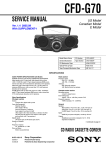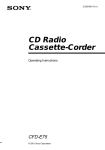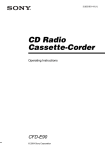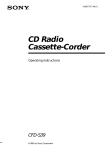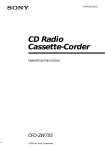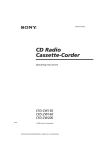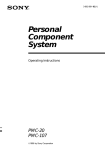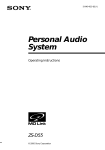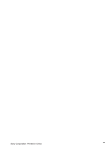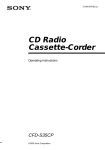Download Sony CFD-S40CP User's Manual
Transcript
3-228-220-12 (1) CD Radio Cassette-Corder Operating Instructions CFD-S40CP ©2001 by Sony Corporation Warning Information To prevent fire or shock hazard, do not expose the player to rain or moisture. For customers in the United States This equipment has been tested and found to comply with the limits for a Class B digital device, pursuant to Part 15 of the FCC Rules. These limits are designed to provide reasonable protection against harmful interference in a residential installation. This equipment generates, uses and can radiate radio frequency energy and, if not installed and used in accordance with the instructions, may cause harmful interference to radio communications. However, there is no guarantee that interference will not occur in a particular installation. If this equipment does cause harmful interference to radio or television reception, which can be determined by turning the equipment off and on, the user is encouraged to try to correct the interference by one or more of the following measures: — Reorient or relocate the receiving antenna. — Increase the separation between the equipment and receiver. — Connect the equipment into an outlet on a circuit different from that to which the receiver is connected. — Consult the dealer or an experienced radio/TV technician for help. You are cautioned that any changes or modifications not expressly approved in this manual could void your authority to operate this equipment. This symbol is intended to alert the user to the presence of uninsulated “dangerous voltage” within the product's enclosure that may be of sufficient magnitude to constitute a risk of electric shock to persons. This symbol is intended to alert the user to the presence of important operating and maintenance (servicing) instructions in the literature accompanying the appliance. CAUTION Owner's Record The use of optical instruments with this product will increase eye hazard. The model number is located at the bottom and the serial number is located in the battery compartment. Record the serial number in the space provided below. Refer to these numbers whenever you call upon your Sony dealer regarding this product. WARNING Do not install the appliance in a confined space, such as a bookcase or built-in cabinet. For customers in Canada To prevent electric shock, match wide blade of plug to wide slot, fully insert. 2 Model No. CFD-S40CP Serial No. Table of contents Basic Operations Basic Operations Playing an audio CD or MP3 files .................. 4 Listening to the radio ...................................... 8 Playing a tape ............................................... 10 Recording on a tape ...................................... 12 The CD Player Using the display .......................................... 14 Locating a specific track ............................... 15 Scanning the beginning of the tracks (Intro Scan) ............................................... 16 Playing tracks repeatedly (Repeat Play) ....... 16 Playing tracks in random order (Shuffle Play) ........................................... 17 Creating your own program (Program Play) 18 The Radio Presetting radio stations ................................ 19 Playing preset radio stations ......................... 20 The Audio Emphasis Selecting the audio emphasis (Sound Mode/MEGA BASS) ................... 21 The Timer Falling asleep to music ................................. 22 Setting Up Choosing the power sources ......................... 23 Additional Information Precautions ................................................... 25 Troubleshooting ............................................ 26 Maintenance ................................................. 28 Specifications ............................................... 29 About “MP3” ................................................ 30 Index ............................................................. 31 3 Basic Operations Playing an audio CD or MP3 files 3 1, 2 Connect the supplied AC power cord (see page 23). 1 PUSH OPEN/CLOSE Press Z PUSH OPEN/CLOSE down to open the CD compartment and place the CD on the CD compartment. With the label side up 2 Close the lid of the CD compartment. PUSH OPEN/CLOSE 3 CD Press u (N on the remote). Display The player turns on (direct power-on) and the player plays all the tracks once. To play a disc with MP3 files, see page 6. 4 Track number Playing time Use these buttons for additional operations POWER Basic Operations Z PUSH OPEN/CLOSE VOLUME +, – u Jog dial x Tip Playback starts from the track you last stopped playing (Resume play). During stop, the track number to be played are displayed. To cancel the resume play to start play from the beginning of the first track, press x in stop mode. To Do this adjust the volume Press VOLUME +, – (VOL +, – on the remote). stop playback Press x. pause playback Press u (X on the remote). Press the button again to resume play after pause. go to the next track Turn the jog dial clockwise. (On the remote, press >.) go back to the previous track Turn the jog dial counterclockwise. (On the remote, press ..) remove the CD* Press Z PUSH OPEN/CLOSE. turn on/off the player Press POWER. * Once you open the CD compartment, the track to start play will change to the beginning of the first track. continued 5 Playing an audio CD or MP3 files (continued) Playing a disc with MP3 files Z PUSH OPEN/CLOSE u Jog dial FOLDER/TRACK Note Before playing a file, this player reads all file and folder information on the disc. Depending on the file structure, it may take more than a minute to read them. During this time, “TOC READING” is displayed. Tip You can use the buttons mentioned on page 5 for additional operations in the same way as playing an audio CD. MP3 indicator M, m 1 Press Z PUSH OPEN/CLOSE down to open the CD compartment and place the CD on the CD compartment (see page 4) . 2 Close the lid of the CD compartment. 3 Press u (N on the remote). The player turns on and the player plays all files of a disc (TRACK mode). When you use a disc with MP3 files, the MP3 indicator lights up. Track number After the file name is displayed, the playing time will appear Playing a specific file (FOLDER mode) Press FOLDER/TRACK during stop to display “ ” in the display, and turn the jog dial to select the folder you want to play, then press u. Folder number After the folder name is displayed, the playing time will appear To go to the next track / go back to the previous track in the selected folder 6 During play Turn the jog dial. (Press > or . on the remote) During stop Press M or m. (Press TUNE + or - on the remote) Example of folder structure and playing order The playing order of the folders and files is as follows: Basic Operations CD-R CD-RW Folder MP3 file 1 1 2 Notes • A folder that does not include an MP3 file is skipped. • Maximum folder number: 255 Maximum file number: 255 • Folder names and file names can be displayed with up to 8 characters. • The characters A - Z, 0 - 9, and _ can be displayed on this player. Other characters are displayed as “-”. • The file name does not correspond to the ID tag. 3 4 4 5 6 5 7 8 9 6 2 q; 3 Track mode Playing all MP3 files from 1, 2, 3...9, 0 Folder mode Playing all MP3 files in the selected folder. (Example: If you select folder 3, the player plays file 4. If you select folder 4, the player plays file 5 and 6.) 7 Listening to the radio 1 2 Connect the supplied AC power cord (see page 23). 1 RADIO Press BAND•AUTO PRESET until the band you want appears in the display (direct power-on). Display BAND AUTO PRESET 2 RADIO BAND AUTO PRESET Hold down + or – (TUNE + or – on the remote) until the frequency digits Indicates an FM stereo broadcast begin to change in the display. The player automatically scans the radio frequencies and stops when it finds a clear station. If you can’t tune in a station, press the button repeatedly to change the frequency step by step. 8 Use these buttons for additional operations POWER Basic Operations VOLUME +, – MODE Tip If the FM broadcast is noisy, press MODE until “Mono” appears in the display and radio will play in monaural. To Press adjust the volume VOLUME +, – (VOL +, – on the remote) turn on/off the radio POWER To improve broadcast reception Reorient the antenna for FM. Reorient the player itself for AM. for FM for AM 9 Playing a tape 2 1 Connect the supplied AC power cord (see page 23). 1 2 STOP/EJECT PLAY Press xZ to open the tape compartment and insert a recorded tape. Use TYPE I (normal) tape only. Close the compartment. Press N. The player turns on (direct power-on) and starts playing. 10 With the side you want to play facing upward Display Use these buttons for additional operations m M X VOLUME +, – POWER To Press adjust the volume VOLUME +, – (VOL +, – on the remote) stop playback xZ fast-forward or rewind M or m pause playback X Press the button again to resume play after pause. eject the cassette xZ turn on/off the player POWER. Basic Operations xZ 11 Recording on a tape 3 1 Connect the supplied AC power cord (see page 23). 1 2 STOP/EJECT CD With the side you want to Press xZ to open the tape compartment and insert a blank tape. record on facing upward Use TYPE I (normal) tape only. Close the compartment. Select the program source you want to record. To record from the CD player, insert a CD (see page 4) and press x on the CD section. RADIO BAND AUTO PRESET 12 To record from the radio, tune in the station you want (see page 8). Display 3 REC Press z to start recording (N is depressed automatically). xZ Basic Operations Use these buttons for additional operations X POWER FUNCTION Tips • Adjusting the volume or the audio emphasis (see page 21) will not affect the recording level. • For the best results, use the AC power as a power source. • To erase a recording, proceed as follows: 1 Insert the tape whose recording you want to erase. 2 Press FUNCTION to select “TAPE”. 3 Press z. To Press stop recording xZ pause recording X Press the button again to resume recording. turn on/off the player POWER 13 The CD Player Checking the information of a disc with MP3 files Using the display You can check information about the CD using the display. Press DISPLAY/ENTER•MEMORY. The display will be changed as follows: During stop in TRACK and FOLDER mode* To display DISPLAY/ ENTER MEMORY the number of total folders and tracks “00” Press DISPLAY/ ENTER•MEMORY once twice Total track number Total folder number Checking the information of an audio CD To check the total track number and playing time Press DISPLAY/ENTER•MEMORY in stop mode. Total playing time Total track number * While the resume function is worked, the information of the track to be played next appears on the display. During play in TRACK mode To display the current track number and the file name the current folder number and the folder name the current track number and playing time Press DISPLAY/ ENTER•MEMORY once twice three times During play in FOLDER mode To check the remaining time Press DISPLAY/ENTER•MEMORY while playing a CD. To display the current track number and the remaining time on the current track* the number of tracks left and remaining time on the CD the current track number and playing time Press DISPLAY/ ENTER•MEMORY once twice three times * For a track whose number is more than 20, the remaining time appears as “--:--”. 14 To display the current folder number and track number the current folder number and the file name the current folder number and the folder name the current folder number and playing time Press DISPLAY/ ENTER•MEMORY once twice three times four times Locating a specific track FUNCTION SLEEP POWER CD/RADIO (AC ONLY) The CD Player You can quickly locate any track using the number buttons on the remote. You can also find a specific point in a track while playing a CD. Tips • When you locate a track numbered over 10, press >10 first, then the corresponding number buttons. Example: To play track number 23, press >10 first, then 2 and 3. • To select a track numbered 100 or more, press >10 twice, then the corresponding number buttons. number buttons MODE 0/10 RADIO To locate a specific track directly a point while listening to the sound a point while observing the display 10 VOL Press the number button of the track > (forward) or . (backward) while playing and hold down until you find the point (On the player, use M or m.) > (forward) or . (backward) in pause and hold down until you find the point (On the player, use M or m.) When playing MP3 files During stop in FOLDER mode, you can select folder by pressing number button. Notes • You cannot locate a specific track if “SHUF” or “PGM” is lit in the display. Turn off the indication by pressing x. • When you find a specific point in a track while playing MP3 files, the sound may not be heard for a few seconds. 15 Scanning the beginning of the tracks (Intro Scan) Playing tracks repeatedly (Repeat Play) You can scan the first 10 seconds of all the tracks in the CD. You can play tracks repeatedly in normal, shuffle or program play modes. INTRO SCAN MODE u Jog dial u x Press INTRO SCAN in stop mode. The indication in the display flashes and the intro scan function starts. To play the track you want to the end during the intro play Press u. When playing MP3 files • In TRACK mode, the player scans all files (up to 255 files) of a disc. • In FOLDER mode, the player scans the first track (up to 255 files) of each folder. To repeat Do this a single track 1 Press MODE until “REP 1” appears. 2 Select the track by turning the jog dial, then press u. all the tracks 1 Press MODE until “REP ALL” appears. 2 Press u. tracks in 1 Press MODE until “SHUF random order REP” appears. 2 Press u. 1 Press MODE until “PGM REP” programed appears. tracks 2 Program tracks (see step 3 on page 18). 3 Press u. To cancel Repeat Play Press MODE until “REP” disappears from the display. On the remote • Use N intead of u. • When you've selected “REP 1”, select the track by pressing the number buttons. 16 When playing MP3 files When you select “REP ALL” • In TRACK mode, the player plays all files (up to 255 files) of a disc repeatedly. • In FOLDER mode, the player plays all files (up to 255 files) in the selected folder repeatedly. Playing tracks in random order (Shuffle Play) You can play tracks in random order. MODE u The CD Player Tip The resume function doesn't work during Repeat Play. x 1 Press x. “CD” appears in the display. 2 Press MODE until “SHUF” appears in the display. 3 Press u to start shuffle play. To cancel Shuffle Play Press MODE until “SHUF” disappears from the display. When playing MP3 files • In TRACK mode, the player plays all files (up to 255 files) of a disc in random order. • In FOLDER mode, the player plays all files (up to 255 files) of the selected folder in random order. Tips • During shuffle play, you cannot select the previous track by turning the jog dial (or by pressing . on the remote). • The resume function doesn't work during Shuffle Play. 17 To cancel Program Play Press MODE until “PGM” disappears from the display. Creating your own program (Program Play) You can arrange the playing order of up to 20 tracks on a CD. MODE DISPLAY/ ENTER MEMORY Jog dial u x 1 Press x. “CD” appears in the display. 2 Press MODE until “PGM” appears in the display. 3 Turn the jog dial to select the track you want to program, and press DISPLAY/ ENTER•MEMORY. Repeat this step. Programed track 4 Playing order Press u to start program play. On the remote 1 Press x. 2 Press MODE until “PGM” appears in the display. 3 Press the number buttons for the tracks you want to program in the order you want. 4 Press N. 18 To check the order of tracks before play Press DISPLAY/ENTER•MEMORY. Every time you press the button, the track number appears in the programed order. To change the current program Press x once if the CD is stopped and twice if the CD is playing. The current program will be erased. Then create a new program following the programing procedure. When playing MP3 files • In TRACK mode, you can program up to 20 files the same as you would for audio CD tracks. • In FOLDER mode, you can program up to 20 folders and play all tracks in the programmed folder in the programmed order. Programed folder Playing order Tips • You can play the same program again, since the program is saved until you open the CD compartment. • You can record your own program. After you’ve created the program, insert a blank tape and press z to start recording. • The resume function doesn't work during Program Play. The Radio Presetting radio stations You can store radio stations into the player’s memory. You can preset up to 30 radio stations, 20 for FM and 10 for AM in any order. DISPLAY/ ENTER• MEMORY 1 Press BAND•AUTO PRESET to select the band. 2 Hold down BAND•AUTO PRESET for 2 seconds until “AUTO” flashes in the display. 3 Press DISPLAY/ENTER•MEMORY. The stations are stored in memory from the lower frequencies to the higher ones. The Radio BAND• AUTO PRESET If a station cannot be preset automatically You need to preset a station with a weak signal manually. 1 Press BAND•AUTO PRESET to select the band. 2 Tune in a station you want. 3 Hold down DISPLAY/ENTER• MEMORY for about 2 seconds. 4 Turn the jog dial until the preset number you want for the station flashes in the display. 5 Press DISPLAY/ENTER•MEMORY. The new station replaces the old one. On the remote 1 Press BAND until the band you want appears in the display. 2 Tune in a station you want. 3 Hold down the number buttons that you want to preset the new station on for about 2 seconds. To select the preset number over 10, press >10 first, then the corresponding number buttons. You need to hold down the last number button to enter for about 2 seconds. (example: To select 12, press >10 and 1 first, then hold down 2 for about 2 seconds.) 19 Playing preset radio stations Once you’ve preset the stations, use the jog dial on the player or the number buttons on the remote to tune in your favorite stations. BAND• AUTO PRESET Jog dial 1 Press BAND•AUTO PRESET to select the band. 2 Turn the jog dial to display the preset number of the station you want. On the remote 1 Press BAND to select the band. 2 Press the number buttons to tune in the stored station. To tune in a preset station over 10, press >10 first, then the corresponding number buttons. (example: To tune in a preset station 12, press >10 and 1 first, then press 2.) 20 The Audio Emphasis Selecting the audio emphasis (Sound Mode/MEGA BASS) Reinforcing the bass sound Press MEGA BASS. “MEGA BASS” appears in the display. To return to normal sound, press the button again. You can adjust the audio emphasis of the sound you are listening to. MEGA BASS Selecting the sound characteristic The Audio Emphasis SOUND Press SOUND repeatedly to select the audio emphasis you want. Choose ROCK POP JAZZ VOCAL OFF To get powerful, clean sounds, emphasizing low and high range audio light, bright sounds emphasizing high and middle range audio percussive sounds, emphasizing bass audio the presence of vocals, stressing middle range audio the whole dynamic range for music such as classical music 21 The Timer Falling asleep to music You can set the player to turn off automatically after 10, 20, 30, 60, 90 and 120 minutes, allowing you to fall asleep while listening to music. SLEEP 1 Play the music source you want. 2 Press SLEEP to display “SLEEP.” 3 Press SLEEP to select the minutes until the player goes off automatically. Each time you press the button, the indication changes as follows: “60” t “90” t “120” t OFF t “10” t “20” t “30”. If 4 seconds have passed after you pressed SLEEP, the minutes in the display are entered. When the preset time has passed, the player goes off automatically. To cancel the sleep function Press POWER to turn off the power. 22 Notes • When you are playing a tape using this function: If the tape length of one side is longer than the set time, the player will not go off until the tape reaches the end. • During the sleep function operating, the backlight in the display does not light. Setting Up Choosing the power sources You can use the AC power or batteries as a power source. AC IN 14 Battery compartment 2 to a wall outlet Insert four size AA (R6) batteries (not supplied) into the battery compartment. These batteries work to save the memory data. 2 Connecting the AC power cord Insert one end of the supplied AC power cord to the AC IN socket located at the rear of the player, and the other end to the wall outlet. Setting Up 1 Inserting the back-up batteries 3 Inserting batteries into the remote Insert four size AA (R6) batteries (not supplied) Replacing batteries Take out the batteries as illustrated. Insert two size AA (R6) batteries (not supplied) continued 23 Choosing the power sources (continued) Replacing batteries With normal use, the batteries should last for about six months. When the remote no longer operates the player, replace all the batteries with new ones. 4 Using the player on batteries Insert six size D (R20) batteries (not supplied) into the battery compartment. To use the player on batteries, disconnect the AC power cord from the player. Notes • When you operate the player on batteries, you cannot turn on the player using the remote. • When you operate the player on batteries, the backlight in the display does not light. Tip Replace the batteries when the OPR/BATT indicator dims or when the player stops operating. Replace all the batteries with new ones. Before you replace the batteries, be sure to take out the CD from the player. 24 Additional Information Precautions On safety • As the laser beam used in the CD player section is harmful to the eyes, do not attempt to disassemble the casing. Refer servicing to qualified personnel only. • Should any solid object or liquid fall into the player, unplug the player, and have it checked by qualified personnel before operating it any further. • Discs with non-standard shapes (e.g., heart, square, star) cannot be played on this player. Attempting to do so may damage the player. Do not use such discs. On power sources • For AC operation, use the supplied AC power cord; do not use any other type. • The player is not disconnected from the AC power source (mains) as long as it is connected to the wall outlet, even if the player itself has been turned off. • Unplug the player from the wall outlet when it is not to be used for an extended period of time. • For battery operation, use six size D (R20) batteries. • When the batteries are not to be used, remove them to avoid damage that can be caused by battery leakage or corrosion. • The nameplate indicating operating voltage, power consumption, etc. is located at the bottom. • If the player is left in a car parked in the sun, be sure to choose a location in the car where the player will not be subjected to the direct rays of the sun. • Since a strong magnet is used for the speakers, keep personal credit cards using magnetic coding or spring-wound watches away from the player to prevent possible damage from the magnet. On operation • If the player is brought directly from a cold to a warm location, or is placed in a very damp room, moisture may condense on the lens inside the CD player section. Should this occur, the player will not operate properly. In this case, remove the CD and wait about an hour for the moisture to evaporate. • If the player has not been used for a long time, set it in the playback mode to warm it up for a few minutes before inserting a cassette. If you have any questions or problems concerning your player, please consult your nearest Sony dealer. continued On placement • Do not leave the player in a location near heat sources, or in a place subject to direct sunlight, excessive dust or mechanical shock. • Do not place the player on an inclined or unstable place. • Do not place anything within 10 mm of the side of the cabinet. The ventilation holes must be unobstructed for the player to operate properly and prolong the life of its components. 25 Precautions (continued) Notes on CDs • Before playing, clean the CD with a cleaning cloth. Wipe the CD from the center out. • Do not use solvents such as benzine, thinner, commercially available cleaners or anti-static spray intended for vinyl LPs. • Do not expose the CD to direct sunlight or heat sources such as hot air ducts, nor leave it in a car parked in direct sunlight as there can be a considerable rise in temperature inside the car. • Do not stick paper or sticker on the CD, nor scratch the surface of the CD. • After playing, store the CD in its case. If there is a scratch, dirt or fingerprints on the CD, it may cause tracking error. Notes on cassettes • Break off the cassette tab from side A or B to prevent accidental recording. If you want to reuse the tape for recording, cover the broken tab with adhesive tape. Side A Tab for side A Tab for side B • The use of a cassette with more than 90 minutes of play time is not recommended except for long, continuous recording or playback. 26 Troubleshooting General The power is not on. • Connect the AC power cord to a wall outlet securely. • Make sure the batteries are inserted correctly. • You cannot turn on the player with the remote when you operate the player on batteries. The power is not on, and “BATTERY ERROR” is displayed. • Make sure the batteries are inserted correctly. • Replace all the batteries with new ones if they are weak. There is no audio. • Make sure the function you want to use appears in the display window. • Adjust the volume. • Unplug the headphones when listening through speakers. Noise is heard. • Someone is using a portable telephone or other equipment that emits radio waves near the player. t Move the portable telephone, etc., away from the player. CD Player “no DISC” lights in the display even when a CD is in place. • Insert the CD with the label surface up. • The CD-R/CD-RW was not finalized. Finalize the CD-R/CD-RW with the recording device. • There is a problem with the quality of the CD-R/CD-RW, recording device, or application software. The CD does not play. • Make sure that the CD compartment is closed. • Place the CD with the label surface up. • Clean the CD. • Take out the CD and leave the CD compartment open for about an hour to dry moisture condensation. • Make sure “CD” appears in the display. The sound drops out. • Reduce the volume. • Clean the CD, or replace it if the CD is badly damaged • Place the player in a location free from vibration. • The sound may drop out or noise may be heard when using poor quality CD-Rs/CDRWs or if there is a problem with the recording device or application software. Radio The audio is weak or has poor quality. • Replace all the batteries with new ones if they are weak. • Move the player away from the TV. • If you are using the remote while listening to AM radio, noise may be heard. This is unavoidable. The picture of your TV becomes unstable. • If you are listening to an FM program near the TV with an indoor antenna, move the player away from the TV. Tape Player The tape does not move when you press an operation button. • Close the tape compartment securely. The REC z button does not function/The tape does not play. • Make sure the safety tab on the cassette is in place. • Make sure “TAPE” appears in the display. The audio is weak/The audio quality is poor. • Clean the heads, pinch roller and capstan (see page 28). • Demagnetize the heads using a demagnetizer (see page 28). The sound is distorted. • The TYPE II (high position) or TYPE IV (metal) tape is being used. Use TYPE I (normal) tape only. Remote The remote does not function. • Replace all the batteries in the remote with new ones if they are weak. • Make sure that you are pointing the remote at the remote sensor on the player. • Remove any obstacles in the path of the remote and the player. • Make sure the remote sensor is not exposed to strong light such as direct sunlight or fluorescent lamp light. • Move closer to the player when using the remote. After trying the above remedies, if you still have problems, unplug the AC power cord and remove all the batteries. After all the indications in the display disappear, plug the power cord and insert the batteries again. If the problem persists, please consult your nearest Sony dealer. The tape does not erase completely. • Clean the erasing head (see page 28). • Replace all the batteries with new ones if they are weak. • The source which was recorded on TYPE II (high position) or TYPE IV (metal) tape using this unit is being played. Record on TYPE I (normal) tape and play. The tape does not record. • Make sure the tape is inserted properly. • Make sure the safety tab of the cassette is in place. 27 Maintenance Cleaning the lens If the lens becomes dirty, it may cause a skipping of sound during CD operation. Clean with a commercially available blower. Cleaning the tape heads and tape path Wipe the heads, the pinch roller and the capstan with a cleaning swab slightly moistened with cleaning fluid or alcohol after every 10 hours of operation for optimum playback and recording quality. To make the best possible recording, however, we recommend that you clean all surfaces over which tape travels before each recording. Record/playback head Capstan Erase head Pinch roller Lens After cleaning, insert a tape when the areas cleaned are completely dry. 28 Demagnetizing the tape heads After 20 to 30 hours of use, enough residual magnetism will have built up on the tape heads to begin to cause loss of high frequency sound and hiss. At this time, you should demagnetize the heads and all metal parts in the tape path with a commercially available tape head demagnetizer. Cleaning the cabinet Clean the cabinet, panel and controls with a soft cloth slightly moistened with a mild detergent solution. Do not use any type of abrasive pad, scouring powder, or solvent, such as alcohol or benzine. Specifications AUDIO POWER SPECIFICATIONS POWER OUTPUT AND TOTAL HARMONIC DISTORTION With 3.2-ohm loads, both channels driven from 150 - 10,000 Hz; rated 1.8 W per channelminimum RMS power, with no more than 10 % total harmonic distortion in AC operation. Power requirements For CD radio cassette-corder: 120 V AC, 60 Hz 9 V DC, 6 size D (R20) batteries For memory back-up: 6 V DC, 4 size AA (R6) batteries For remote control: 3 V DC, 2 size AA (R6) batteries Power consumption AC 20 W Battery life For CD radio cassette-corder: FM recording Other Specifications Sony R20P: approx. 15 h CD player section Sony alkaline LR20: approx. 40 h System Compact disc digital audio system Laser diode properties Material: GaAlAs Wave length: 780 nm Emission duration: Continuous Laser output: Less than 44.6 µW (This output is the value measured at a distance of about 200 mm from the objective lens surface on the optical pick-up block with 7 mm aperture.) Spindle speed 200 r/min (rpm) to 500 r/min (rpm) (CLV) Number of channels 2 Frequency response 20 - 20 000 Hz +1/–2 dB Wow and flutter Below measurable limit Tape playback Radio section Frequency range FM: 87.6 - 108 MHz AM: 530 - 1 710 kHz Antennas FM: Telescopic antenna AM: Built-in ferrite bar antenna Sony R20P: approx. 10 h Sony alkaline LR20: approx. 25 h CD playback Sony R20P: approx. 1.5 h Sony alkaline LR20: approx. 6 h Dimensions Approx. 420 × 161 × 266 mm (w/h/d) (16 5⁄8 × 6 3⁄8 × 10 1⁄2 inches) (incl. projecting parts) Mass Approx. 4.6 kg (10 lb. 2 oz) (incl. batteries) Supplied accessories AC power cord (1) Remote control (1) Design and specifications are subject to change without notice. Optional accessories Sony MDR headphones series Cassette-corder section Recording system 4-track 2 channel stereo Fast winding time Approx. 120 sec. with Sony cassette C-60 Frequency response TYPE I (normal): 70 - 13 000 Hz General Speaker Full range: 10 cm (4 in.) dia., 3.2 Ω, cone type (2) Outputs Headphones jack (stereo minijack) For 16 - 68 Ω impedance headphones Power output 2.3 W + 2.3 W (at 3.2 Ω, 10 % harmonic distortion) 29 About “MP3” What is the MP3? MP3 (MPEG 1 Audio Layer-3) is a standard technology and format for compressing a sound sequence. The file is compressed to about 1/10 of its original size. Sounds outside the range of human hearing are compressed while the sounds we can hear are not compressed. Playable “MP3” files on this player You can only play MP3 files recorded by following requirements. USABLE MEDIA CD-Rs and CD-RWs USABLE DISC FORMAT You can use ISO 9660 Level 1 format discs, not including the “expanded” format. In some cases, MP3 files that are recorded in a format other than ISO 9660 Level 1 may not play normally or the file and folder names may not be displayed correctly. The major specifications of the ISO 9660 Level 1 format are as follows: • Maximum directory steps: 8 • Usable characters for a file/folder name: A - Z, 0 - 9, _ (underscore) • Maximum number of characters for a file name: 12 including quotation marks and a 3-character extension code Notes • The file names and folder names must be ISO 9660 level 1 compliant. • When naming, be sure to add the file extension “mp3” to the file name. • If you put the extension “mp3” to a file other than MP3, the player cannot recognize the file properly and will generate random noise that could damage your speakers. • The file name does not correspond to the ID tag. THE USABLE NUMBER OF FOLDERS/FILES • Maximum folder number: 255 • Maximum file number: 255 SETTINGS FOR COMPRESSION SOFTWARE AND WRITING SOFTWARE • To compress a source for an MP3 file, we recommend setting the transfer bit rate of the compression software to “44.1 kHz”, “128kbps”, and “Constant Bit Rate”. • To record up to the maximum capacity, set to the “halting of writing”. • To record at one time up to the maximum capacity on media that has nothing recorded it, set to “Disc at Once”. NOTES FOR SAVING FILES ON THE MEDIA When the disc is inserted, the player reads all the files on that disc. If there are many folders or non-MP3 files on the disc, it may take a long time for play to begin or for the next MP3 file to start play. Do not save unnecessary folders or files other than MP3 ones in the disc to be used for MP3 listening. We recommend that you do not save other types files or unnecessary folders on a disc that has MP3 files. 30 Index A Audio emphasis 21 B Batteries for player 24 memory back-up 23 for remote 23 C CD player 4 Choosing power sources 24 Cleaning cabinet 28 tape heads and tape path 28 Connecting AC power cord 23 Creating your own program 18 D, E, F, G, H, I, J, K Demagnetizing the tape heads 28 Display 14 L Listening to the radio 8 Locating a specific point 15 M, N, O Maintenance 28 MEGA BASS 21 MP3 about MP3 30 display 14 playing mode 6 playing order 7 P, Q Playing a CD 4 a tape 10 intro scan 16 preset radio stations 20 tracks in random order 17 tracks repeatedly 16 Power sources 23 Precautions 25 Presetting radio stations 19 Program Play 18 R Radio stations playing 20 presetting 19 Recording on a tape 12 Repeat Play 16 S Scanning the beginning of the tracks 16 Selecting audio emphasis 21 tracks 5 Setting up 23 Shuffle Play 17 SOUND 21 Specifications 29 T Timer falling asleep to music 22 Troubleshooting 26 U, V, W, X, Y, Z Using the display 14 31 Sony Corporation Printed in China
































